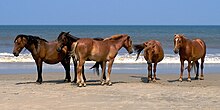Banker horse

Horses near Corolla
|
|
| Country of origin | United States |
|---|---|
| Traits | |
| Distinguishing features | Small, compact conformation |
The Banker horse is a breed of feral horse (Equus ferus caballus) living on barrier islands in North Carolina's Outer Banks. It is small, hardy, and has a docile temperament. Descended from domesticated Spanish horses and possibly brought to the Americas in the 16th century, the ancestral may have become feral after surviving shipwrecks or being abandoned on the islands by one of the exploratory expeditions led by Lucas Vázquez de Ayllón or Sir Richard Grenville. Populations are found on Ocracoke Island, Shackleford Banks, Currituck Banks, and in the Rachel Carson Estuarine Sanctuary.
Although they can trample plants and ground-nesting animals and are not considered to be indigenous to the islands, Bankers are allowed to remain due to their historical significance. They survive by grazing on marsh grasses, which supply them with water as well as food, supplemented by temporary freshwater pools.
To prevent overpopulation and inbreeding, and to protect their habitat from being overgrazed, the horses are managed by the National Park Service, the state of North Carolina, and several private organizations. The horses are monitored for diseases, such as equine infectious anemia, an outbreak of which was discovered and subsequently eliminated on Shackleford in 1996. They are safeguarded from traffic on North Carolina Highway 12. Island populations are limited by adoptions and by birth control. Bankers taken from the wild and trained have been used for trail riding, driving, and occasionally for mounted patrols.
...
Wikipedia
